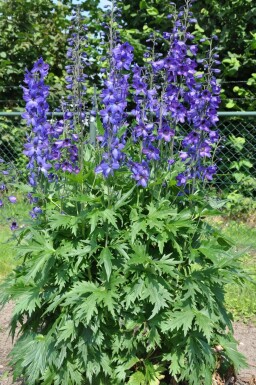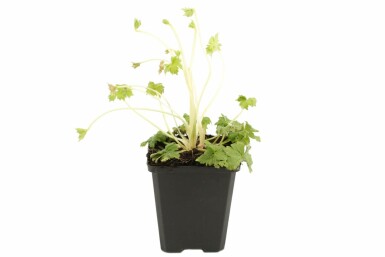

150cm




Embrace the splendor of Delphinium, commonly referred to as larkspur, a genus that brings a touch of stately elegance to any garden. With its majestic spires of blue and purple blossoms, this plant is cherished for its traditional charm and ability to add height and color to floral arrangements. The lush green foliage forms a perfect backdrop for the vibrant blooms, which grace gardens with their presence through the warmer months. Ideal for creating an eye-catching border or as a centerpiece in a decorative pot, Delphiniums are a true celebration of nature's beauty and a testament to the diversity of flora that graces our world.
Delphinium, commonly known as larkspur, is a genus revered for its majestic spires of flowers that grace gardens with their ethereal blue and purple hues. These plants are a quintessential element of a traditional cottage garden, adding both height and a splash of color to the midsummer border. With an upright growth habit, Delphiniums provide structure and a visual focal point when placed at the back of a border or as a standalone feature in the garden.
The Delphinium genus encompasses a variety of species, each displaying the characteristic tall flowering stalks that are beloved by garden enthusiasts and pollinators alike. These perennials thrive in locations that receive full sun to partial shade and are known for their ease of integration into diverse garden designs.
The Delphinium pacific 'Black Knight' stands as a majestic presence in any garden with its spires of deep indigo blossoms. This particular variety exudes a regal charm that can elevate the aesthetic of your outdoor space, captivating onlookers with its statuesque form and vibrant hues.
We would like to provide some tips on how to plant and care for a Delphinium. By following these tips, you can be sure to enjoy your Delphinium for a long time.
For optimal growth, it is recommended to position this species in a location that receives full sun to partial shade. The plant's success is closely tied to exposure to adequate sunlight, which encourages prolific blooming in hues of blue and purple during the summer months. While it adapts to a variety of soil conditions, ensuring the soil is well-drained is crucial to prevent waterlogging, which can be detrimental. The site should offer protection from strong winds as well, due to its upright growth habit and the height it can achieve, which is up to 1.5 meters.
For optimal growth, Delphinium should be planted in well-drained soil that can accommodate its upright growth habit. These plants thrive in a location that offers full sun to partial shade. When planting, ensure a hole is spacious enough for the root ball to fit comfortably, and the top of the root ball is level with the soil surface. Fill the hole with soil, pressing down firmly to eliminate air pockets, and water thoroughly. Maintain an average watering schedule, allowing the soil to remain moist but not waterlogged to support their moderate water needs and encourage robust growth.
To ensure vigorous growth and optimal flowering, Delphiniums benefit from regular fertilization. Apply a balanced, slow-release fertilizer early in the spring as new growth appears. A second application should follow just before the onset of the blooming period in early summer to support the development of the stunning blue and purple spires. It is crucial to incorporate the fertilizer into the soil around the plants, being careful to avoid direct contact with the foliage or stems to prevent any potential burn. Water the area well after fertilizing to help disperse the nutrients into the soil. For Delphiniums, which are not drought-tolerant, consistent moisture combined with proper feeding will contribute to their impressive height and vibrant floral displays throughout the summer months.
Delphiniums are low-maintenance when it comes to pruning. After the first flush of blooms fade in early summer, cutting back the flower stalks to the base may encourage a second bloom period in late summer or early autumn. At the end of the growing season, once the foliage has yellowed, it should be cut down to ground level. This practice helps to maintain a tidy appearance and prepares the plant for its dormant period, ensuring a vigorous return in the spring.
Delphiniums thrive with consistent moisture, particularly during the blooming season of June through August. They require an adequate supply of water to sustain their tall, stately spikes of blue and purple flowers. However, overwatering or allowing the plants to sit in waterlogged soil can be detrimental to their health. It is essential to balance the watering regimen by ensuring the soil is well-drained. During periods of dry weather, supplementary watering may be necessary to maintain the average water needs of these plants. Regular monitoring and adjusting watering according to rainfall and temperature will promote their vigorous growth and spectacular floral display.
The Delphinium boasts a majestic presence in any garden with its towering spires of vibrant blooms. This species thrives when planted in fertile, well-drained soil and benefits from staking to support its tall stems. It's important to space these plants properly, as good air circulation promotes robust health. In addition to their visual appeal, they are known to attract pollinators, enhancing the ecological harmony of your outdoor space. Consider incorporating them into cottage garden designs for an enchanting, fairy-tale aesthetic.
To rejuvenate and maintain the health of Delphinium, division is recommended. This process, ideally carried out in spring or autumn, involves gently lifting the plant from the soil and carefully separating it into smaller sections. Each section should have its own root system and several shoots. Replant these divisions promptly, ensuring they are spaced adequately to accommodate their vertical growth habit. Not only does division stimulate robust growth, but it also presents an opportunity to expand your collection of these majestic spires of blue and purple blooms.
Delphinium, with its towering spires of vibrant blooms, is a true showstopper in any garden. This perennial's majestic presence adds vertical interest and a touch of elegance, making it an ideal choice for gardeners aiming to create a striking floral display.
